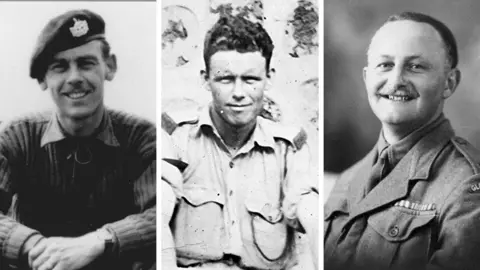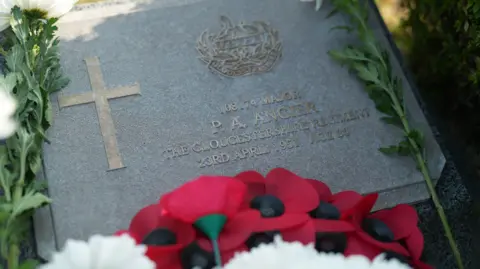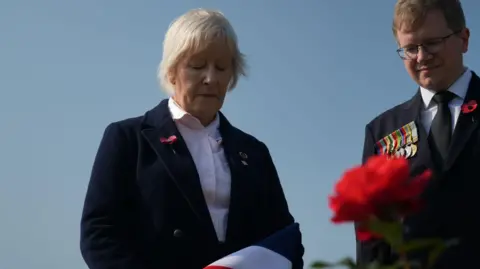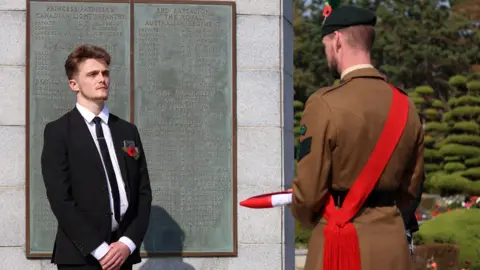Families reunite with bodies of missing British soldiers 70 years on
 BBC
BBCFrom his wheelchair, Michael Northey watches quietly over his father’s grave, and lays a flower for the very first time.
“This is the closest I’ve been to him in 70 years, which is ridiculous,” he jokes poignantly.
Born into a poor family in the backstreets of Portsmouth, Michael was still a baby when his father, the youngest of 13 children, left to fight in the Korean War. He was killed in action, his body never identified.
For decades, it lay in an unmarked grave in the UN cemetery in Busan, on Korea’s south coast, adorned with the plaque ‘Member of the British Army, known unto God’.
Now it bears his name – Sergeant D. Northey, died 24 April 1951, age 23.
Sergeant Northey, along with three others, are the first unknown British soldiers killed in the Korean War to be successfully identified, and Michael is attending a ceremony, along with the other families, to rename their graves.

Michael had spent years doing his own research, hoping to find out where his father was buried, but had eventually given up.
“I’m ill and don’t have a lot of time left myself, so I’d written it off. I thought I’d never find out,” he says.
But a couple of months ago, Michael received a phone call. Unknown to him, researchers at the Ministry of Defence had been conducting their own investigation. When he heard the news, he “wailed like a banshee for 20 minutes”.
“I can’t describe the emotional release,” he says, smiling. “This had haunted me for 70 years. The poor lady who phoned me, I felt sorry for her!”
 Michael Northey
Michael NortheyThe woman on the other end of the phone was Nicola Nash, a forensic researcher from the Joint Casualty and Compassionate Centre in Gloucester, who ordinarily works to identify victims from the First and Second World Wars.
Tasked for the first time with finding the Korean War dead, she had to start from scratch - by first compiling a list of the 300 British soldiers still missing, of whom 76 were buried in the cemetery in Busan.
Nicola went through their burial reports, and found just one man had been buried wearing sergeant stripes from the Gloucester Regiment, as well as one major.
After trawling the national archives and cross referencing eyewitness accounts, family letters and war office reports, Ms Nash was able to identify these men as Sergeant Northey and Major Patrick Angier.

Both were killed in the famous Battle of Imjin River, in April 1951, as the Chinese Army - which had joined the war on the North Korean side - tried to push the allied forces down the peninsula to retake the capital Seoul.
Despite being hugely outnumbered, the men held their position for three days, giving their comrades enough time to retreat and successfully defend the city.
The issue at the time, Ms Nash explains, is that because the battle was so bloody, most of the men were either killed or captured, leaving no one to identify them.
The enemy had removed and scattered their dog tags. It was not until the prisoners of war were released that they were able share their accounts of the battle. No one had thought to go back and piece the puzzles together – until now.
For Ms Nash, this has been a six-year “labour of love”, made slightly easier, she admits, by having some of the men’s children still alive to draw on, something that has also made the process more special.
“The children have spent their whole lives not knowing what happened to their fathers, and for me to be able to do this work and bring them here to their graves, to say their goodbyes and have that closure, means everything," she says.

At the ceremony, the families sit on chairs amidst the long rows of small stone graves which mark the thousands of foreign soldiers who fought and died in the Korean War. They are accompanied by serving soldiers from their loved ones’ former regiments.
Major Angier’s daughter, Tabby, now 77, and his grandson Guy, stand to read excerpts of letters he wrote from the front line.
In one of his final letters, he writes to his wife: “Lots of love to our dear children. Do tell them how much Daddy misses them and will come back as soon as he has finished his work."
Tabby was three years old when her father left for the war, and her memories of him are fractured: “I can remember someone standing in a room and canvas bags piling up, which must have been his equipment to go to Korea. But I can’t see his face,” she says.
At the time of her father’s death, people didn’t like to talk about wars, Tabby says. Instead, people in her small Gloucestershire village used to remark: “Oh, those poor children, they’ve lost their father."
“I used to think that if he’s lost, they’re going to find him,” says Tabby.
But as the years passed, and she learnt what had happened, Tabby was told her father’s body would never be found. The last record of his whereabouts suggested his body had been left under an upturned boat on the battlefield.
Tabby had twice previously visited the cemetery in Busan, in an attempt to get as close to her father as she thought possible - not knowing his actual grave was here all along.
“I think it will take some time to sink in,” she says, from his newly-adorned graveside.

The shock has been even greater for 25-year-old Cameron Adair, from Scunthorpe, whose great, great uncle, Corporal William Adair, is one of two soldiers from the Royal Ulster Rifles identified by Ms Nash. The other is Rifleman Mark Foster, from County Durham.
Both men were killed in January 1951 as they were forced to retreat by a platoon of Chinese soldiers.
Corporal Adair did not have children, and when his wife died so did his memory, leaving Cameron and his family unaware of his existence.
Finding out his relative “helped bring freedom to so many people” has brought Cameron “a real sense of pride,” he says.
“Coming here and witnessing this firsthand has really brought it home”.
Now a similar age to his uncle when he was killed, Cameron feels inspired and says he would like to serve should the need arise.
Ms Nash is now gathering DNA samples from the relatives of the other 300 missing soldiers, in the hope she can give more families the same peace and joy she has brought to Cameron, Tabby and Michael.
“If there are still British personnel missing, we will keep trying to find them,” she says.
